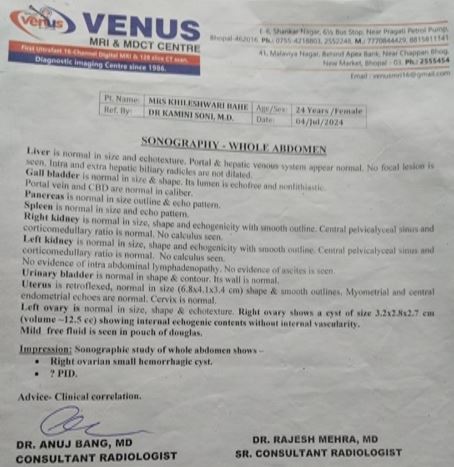Effect of Panchakarma in Ovarian Cyst - A Case Report
DOI:
https://doi.org/10.21760/jaims.10.5.49Keywords:
Ovarian cyst, Granthi, Ayurveda, Panchakarma, Basti Karma, Virechana Karma, Hemorrhagic cyst, Ayurvedic treatment, Case ReportAbstract
Ovarian cysts are common, fluid-filled sacs that develop on or within a woman's ovaries. The symptoms largely depend on the size of the cyst. In allopathic medicine, treatment typically includes the use of combined oral contraceptive pills. If the cyst continues to grow after three months of medication, surgical options such as laparoscopy or laparotomy may be suggested. However, contraceptive pills can have several side effects. In Ayurveda, ovarian cysts can be compared to a condition called Granthi. The term Granthi is found in classical Ayurvedic texts like Sushrut Samhita, Madhavnidan, Bhavprakash, and Yogratnakar. According to Chakrapani, Granthi refers to a specific type of glandular or nodular swelling. This condition is understood to include various benign tumors or cysts. The treatment of Granthi - particularly the Vataja, Pittaja, and Medoja types that are inflamed or suppurated - involves specific Ayurvedic therapies. For Kaphaja Granthi, gentle massage is recommended to soften the swelling. These descriptions align closely with the characteristics of subcutaneous cysts, including ovarian cysts. A case study demonstrated the successful treatment of a simple hemorrhagic ovarian cyst measuring 3.2 x 2.8 x 2.7 cm using Ayurvedic methods. After four months of therapy, which included Panchakarma procedures like Basti Karma and Virechana Karma along with internal herbal medications, the patient experienced complete relief from symptoms and full resolution of the cyst.
Downloads
References
Crum CP. The female genital tract. In: Kumar V, Abbas AK, Fausto N, editors. Robbins and Cotran pathologic basis of disease. 7th ed. China: Elsevier Saunders; 2005. p. 1092–105.
Grimes DA, Jones LB, Lopez LM, Schulz KF. Oral contraceptives for functional ovarian cysts. Cochrane Database Syst Rev. 2014;(4):CD006134.
Hongqian L, Xiangao W, Donghao L, Zhihong L, Gang S. Ovarian masses in children and adolescents in China: analysis of 203 cases. J Ovarian Res. 2013;6:47.
Farghaly SA. Current diagnosis and management of ovarian cysts. Clin Exp Obstet Gynecol. 2014;41:609–12.
Tripathi B. Charaka Samhita. Chikitsasthana, 12/74. Varanasi: Chaukhambha Bharati Academy; 2013.
Tiwari P. Ayurvedic Prasutitantra Evum Streerog. Part 2. Varanasi: Chaukhamba Orientalia; 2014. p. 358–60.
Government of India. The Ayurvedic Formulary of India. Part I. Part A. 1:5 Ashokarishta (Bhaishajyaratnavali Strirogadhikara). 2nd ed. New Delhi: Dept. of AYUSH, Ministry of Health and Family Welfare; 2003. p. 8.
Sandhya T, Lathika KM, Pandey BN, Mishra KP. Potential of traditional ayurvedic formulation, Triphala, as a novel anticancer drug. Cancer Lett. 2006;231:206–14. doi: 10.1016/j.canlet.2005.01.035.
Deep G, Dhiman M, Rao AR, Kale RK. Chemopreventive potential of Triphala (a composite Indian drug) on benzo(a)pyrene-induced forestomach tumorigenesis in murine tumor model system. J Exp Clin Cancer Res. 2005;24(4):555–63.
Kalaiselvan S, Rasool MK. Triphala herbal extract suppresses inflammatory responses in LPS-stimulated RAW 264.7 macrophages and adjuvant-induced arthritic rats via inhibition of NF-kB pathway. J Immunotoxicol. 2016;13(4):509–25. doi: 10.3109/1547691X.2015.1136010.
Prarthana T, Rao VG. Management of secondary amenorrhea and PCOS by Vamana and Virechana: a case report. J Res Ayurvedic Sci. 2022;6(1):11–6. doi: 10.4103/jras.jras_37_21.
Tripathi B. Charaka Samhita. Siddhisthana, 1/31. Varanasi: Chaukhambha Bharati Academy; 2013.
Tripathi B. Charaka Samhita. Siddhisthana, 1/44–45. Varanasi: Chaukhambha Bharati Academy; 2013.















